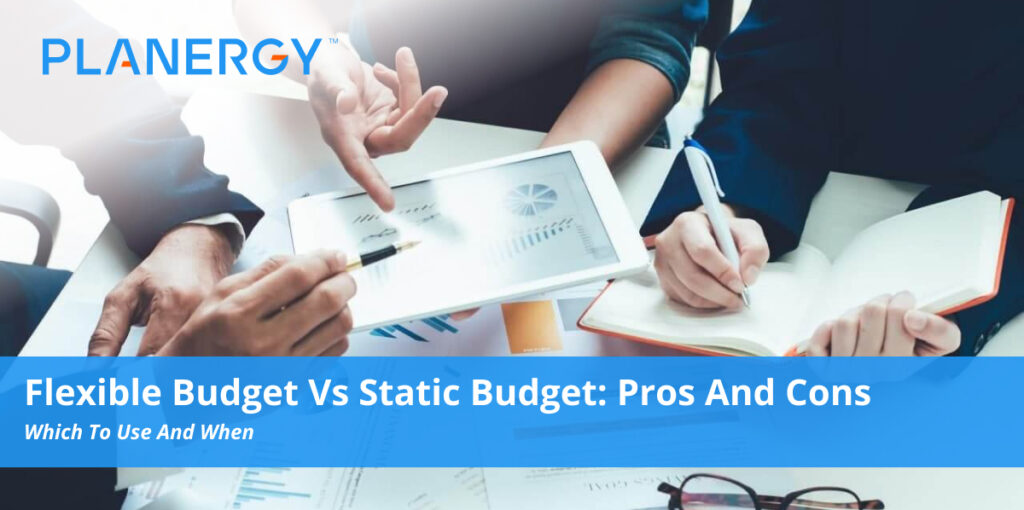Businesses can use flexible budgets or static budgets. Many organizations opt to use both since static budgets are good for some things and flexible budgets are good for others.
They both play a part in good business accounting and are often used in personal finance, too.
Static budgets are great for keeping your production costs in line. They are useful to encourage your procurement staff to obtain the goods and services you need at the lowest possible price.
In some industries, a flexible budget can be enough for an entire company’s budget, but it’s best used as part of the larger overall budget. It’s the best choice for things like a variable expense account.
What is a Static Budget?
Static budgets are projection tools designed to estimate business expenses for an accounting period.
There will be discrepancies between the budgeted amount and the actual spending amount, especially if you deal with fluctuating costs of raw materials or the cost of goods sold. These discrepancies are known as a static budget variance.
When you reach the end of a production cycle and need to account for the actual expenses, accurate financial reporting requires you to combine the static budget variances with the initial static budget.
To keep things simple, think of a static budget as a projection budget.
You’ll estimate all your costs – fixed costs, variable costs, etc. Throughout the accounting period, you’ll keep track of the actual figures, including:
● Actual output
● Actual sales volume
● Actual revenue
You can compare the budgeted about to the actual costs and actual results. With that information, you can make adjustments to your budget forecasting for the next period, to limit the unfavorable variances (those where you spent more money than planned) for the next budget period.
Static budgets remain the same, even if you have significant changes from the assumed circumstances during planning.
Pros of a Static Budget
● Easy to implement and follow since they do not require constant updating
● Offers great insight into a company’s costs and profits, when you perform a variance analysis
● Built-in cost controls and accountability since there’s no “wiggle room” built into the budget
● Great for a master budget
● Simplifies taxes and makes it easier to estimate taxes owed
Cons a Static Budget
● No flexibility. If the budget is built on a certain production level, and production volume changes significantly, resources can’t easily be reallocated to account for the change.
What is a Flexible Budget?
A flexible budget is a great performance evaluation tool when used with a static budget. It is essentially a way to comprehensively account for the static budget’s cost variance.
You can keep your flexible budget expenses to a minimum by offering performance incentives to your employees, as long as they are directly related to sticking to the static budget.
Flexible budgets are a business cycle analysis tool. They cannot be created prior to the end of the business cycle.
Looking at the flexible budget at the end of the cycle allows you to make adjustments for the next cycle’s static budget forecasts. This way, the budget matches the changing landscape of operating costs.
Your flexible budget is the end of period actual accounting of expenses. You can use it to make comparisons with the static budget.
A flex budget uses percentages of revenue or expenses, instead of fixed numbers like a static budget. This approach means you’ll easily be able to make changes in the budgeted expenses that are directly tied to your actual revenue.
For example, if you build your static budget based on 1,000 units, but only produce or sell 600 units, the static budget is off.
The flexible budget allows you to account for that change, accurately reflecting the situation for 600 units. It works the other way, too – if you end up needing to produce 1,400 units, you can use the flexible budget to scale up your total cost.
Let’s look at an example, using Blue Company.
Blue Company has a budget of $10 million in revenue and $4 million in costs of goods sold. Of that $4 million budget, only $1 million is fixed. The remaining $3 million is variable but directly connected to revenue. As such, the variable portion of the costs of goods sold is 30% of revenues.
That means, if efforts scale up to $15 million, then the variable portion of the costs of goods sold moves from $3 million to $4.5 million.
If efforts scale down to $8 million, then the variable portion goes from $3 million to $2.4 million.
Pros of a Flexible Budget
● Allows you to roll with the punches so you can easily address changes in your circumstances and market conditions, such as business volume and market fluctuations.
● Resource allocation is less rigid
● Provides a more accurate reflection of your current financial state
● Makes it easier for your organization to mitigate risk while pursuing new opportunities
● Helps to account for unexpected expenses
● Better cost controls
Cons of a Flexible Budget
● Flexible budgets are more time consuming and require additional oversight and maintenance
● Limits the ability to plan in areas where the budget is changing
● Predictions don’t last as long. Usually, they last months, instead of quarters
● There’s less accountability to stick to the original budget
So, how can you have better cost controls, but less accountability?
If you’re keeping an eye on the budget, you can easily reallocate funds as needed. Let’s say you spent less on overhead costs than you expected, but new taxes mean your manufacturing department won’t meet its numbers.
By diverting what you would spend on your utilities and in-office expenses to a one-time effort to negotiate a better contract with other suppliers, you’ll end up with more predictable costs in the future.
In other words, you can take a favorable variance in one category of your budget, and apply it to another flexible budget variance in hopes of producing more profit.
The key lies in keeping a disciplined process when justifying budget increases. When everyone knows there’s not a strict expectation to stay in line with the static line item, there’s always the temptation to ask for more.
You have to be honest with yourself. If your executives don’t have the heart to say no, even when there are funds available to take on an unbudgeted project, flexible budgeting may not be the solution for your organization.
If you want to be able to make budget changes as circumstances change, you need a flexible budget.
When to Use a Flexible or Static Budget
So which type of budget should you use and when? Most businesses should take advantage of both kinds of budget.
The only exception to this approach should be during business cycles when your company manages to strictly adhere to the original static budget. In this situation, the information within the static and flexible budget would be the same.
Flexible budgets are most appropriate for businesses that operate with an increased variable cost structure, where costs are primarily attached to activity levels.
A flexible budget makes it easier for businesses to see more variances. During your higher-earning months, you would save for the months where your income isn’t as high.
Consequences of Inaccurately Monitoring Your Budget
Companies that do not effectively track shifting expenses compared to their initial static budget may find it difficult to report their actual earnings. This can cause negative legal implications.
Organizations have a vested interest in providing accurate information to their shareholders, so they can accurately manage portfolios and adjust dividend expectations.
PLANERGY software includes budgeting tools that make it easy to adhere to both a flexible and fixed budget, depending on your needs.




